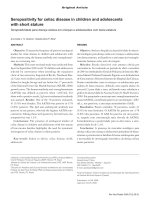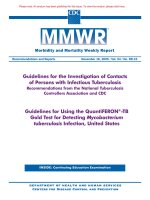New ESPGHAN guidelines for the diagnosis of Coeliac Disease in Children and Adolescents pptx
Bạn đang xem bản rút gọn của tài liệu. Xem và tải ngay bản đầy đủ của tài liệu tại đây (545.63 KB, 33 trang )
New ESPGHAN guidelines for the
diagnosis of Coeliac Disease in
Children and Adolescents
Steffen Husby
Hans Christian Andersen Children’s Hospital
Odense University Hospital, Denmark
Agenda
• Change in clinical paradigm
• Definitions of coeliac disease
• New diagnostic guidelines
• Algorithms
Interlaken ESPGHAN criteria (1979)
1. Small intestinal biopsy: villous atrophy
2. Gluten free diet for 1-2 years
3. Biopsy: normal.
4. Re-introduction of gluten
5. Biopsy: villous atrophy
McNeish et al. Arch Dis Childh 1979;54:783
Revised ESPGHAN criteria 1990
1. Small intestinal biopsy: villous atrophy
2. Clinical and serological improvement
after 2-3 months
• No further biopsy
• Provided age > 2 years
Walker‐Smithetal.ArchDisChild1990;65:99
General:
Puberty & growth delay
Malignancies
Anemia
GI system:
Diarrhea, vomiting
Distension, pain
Malnutrition, weight loss
Hepatitis, cholangitis
Bone:
Osteoporosis, fractures
Arthritis
Dental anomalies
CNS:
Ataxia, seizures
Depression
Heart:
Carditis
Skin & mucosa:
Dermatitis herpetiformis
Aphtous stomatitis
Hair loss
Reproductive system:
Miscarriage
Infertility
Modified from
Rewers, Gastroenterology 2005
Celiac disease as a multiorgan autoimmune disease
Coeliac disease
Type 1 Diabetes
Dermatitis
herpetiformis
Autoimmune hypothyroidism
Adrenal antibodies
Hansen et al. unpublished
Patient
Towards a new definition of
coeliac disease
Chronic
Multi-organ
Small intestinal inflammation
Transglutaminase-related
ESPGHAN working group, 2011
Suggestion: New definition
an immune-mediated systemic disorder
elicited by gluten and related prolamines
in genetically (mainly HLA) susceptible individuals
characterized by a combination of:
• gluten dependent clinical manifestations
• anti-tissue transglutaminase (TG2) antibodies
• enteropathy
Husby et al. JPGN 2012
ESPGHAN classification
Silent CD:
positive CD antibodies and biopsy
findings, not sufficient symptoms to warrant
clinical suspicion of CD
Latent CD:
positive CD antibodies, no villous
atrophy. The patient has had a gluten-
dependent enteropathy. Patient may/may not
have symptoms
Potential CD:
positive antibodies, but no villous
atrophy. Patient may/may not have symptoms.
CD may or may not develop
The Oslo Definitions
Coeliac disease is a chronic small intestinal
immune-mediated enteropathy precipitated by
exposure to dietary gluten in genetically
predisposed individuals.
Discourage the use of classical vs. non-classical,
typical vs. atypical
Discourage the use of the term latent CD
Ludvigsson et al. Gut 2012
85 % of those who are compliant to the 1990
criteria want them to be changed
• challenge policy: 100 %
• HLA should be included for DX 80%
ESGPHAN member Questionnaire
C.Ribesetal.JPGN2012
Previous evidence-based
guidelines for CD diagnosis
AHRQ (USA, 2004)
Adults and children
NICE guidelines (UK, 2009)
Adults and children
For GP’s and general paediatricians
None questioned the biopsy
Rostom A, et al Celiac Disease. EvidenceReport/ Technology Assessment
No. 104. AHRQ Publication No. 04-E029-2, 2004
NICE Clinical Guidelines 86. Coeliac Disease:
Recognition and assessment of coeliac disease. UK, May 2009
Guidelines: AHRQ (USA, 2004)
1. Sensitivity/specificity of
serological tests
2. Prevalence / incidence
of CD
3. CD associated
lymphoma
4. Consequences of testing
for CD
5. Interventions for
adherence to a gluten-
free diet
1. Sensitivity and specificity
of EMA and TG2 ab quite
high
2. CD common, prevalence
in the general population
likely close to 1:100
3. Education/participation in
coeliac societies improves
compliance with a GFD
RostomA,etal CeliacDisease.EvidenceReport/TechnologyAssessmentNo.104.
AHRQPublicationNo.04‐E029‐2,2004
Main issues Conclusions
Evidence-based criteria for
clinical decisions
1. Formulate an answerable
question
2. Track down the best evidence
3. Critically appraise the evidence
for
• Validity
• Impact (size of the benefit)
• Applicability
4. Integrate with clinical
expertise and patient values
5. Evaluate our effectiveness and
efficiency
• keep a record/improve the
process
Evidence-based
medicine
Patient preferences
and values
Devereaux2004
Clinical
circumstances
Literature search
Search 1: n=1,418
EMBASE, Medline
01.01.2004-15.07.2007
Search 2: n=402
Medline
17.07.07-15.09.2008
Search 3: n=778
Embase 15.07.2007-01.09.2009
Medline 15.09.2008-01.09.2009
n=2,598
Entering Level 1 screening
n=2,242 + 22 no full text
excluded
n=334 Full text
Entering Level 2 screening
n=247
excluded
n=87
Entering Level 3 screening
n = 16 publications
Included in data synthesis
N = 71 excluded based on E1-8:
No biopsy
Age
Quality etc.
Giersiepen et al. 2010
Grading Evidence
Type of study: Diagnosis
Study Quality
Level 1: Good quality patient-oriented
evidence
Validated clinical decision rule
Systematic Review(SR)/meta-
analysis of high quality studies
High quality diagnostic cohort study
Level 2: Limited quality patient-
oriented evidence
Unvalidated clinical decision rule
SR/meta-analysis of lower quality
studies or studies
Lower quality diagnostic cohort study
or diagnostic case control study
Level 3: Other evidence Consensus guidelines, extrapolations
from bench research, usual practice,
opinion, disease-oriented evidence,
case series etc.
Ebell MH et al. JABFP 2004
Example statement:
Increased prevalence of CD in children with
• Type 1 diabetes 2–12
• Down’s syndrome 5-12
• Autoimmune thyroid disease up to 7
• Turner syndrome 2-5
• Williams’ syndrome up to 9
• IgA deficiency 2-8
• Autoimmune liver disease 12-13
• First degree relatives with CD 10-20
%
Recommendation: (↑↑) offer testing for CD
of children and adolescents with the
following conditions:
Type 1 diabetes
Down’s syndrome
Autoimmune thyroid disease
Turner syndrome
Williams’ syndrome
IgA deficiency
Autoimmune liver disease
1st degree relatives with CD
Coeliac Antibodies
• IgA Anti-TG2 antibody
• IgA Endomysial antibody (EMA)
• IgA and IgG Deamidated Gliadin Peptide (DPG)
antibody
• NOT: IgA and IgG anti-gliadin antibodies
DISEASE PREDICTION BY ANTIBODIES
(pooled estimates with 95% confidence values; § indicates high hetereog neity)
Positive
likelihood ratio
Negative
likelihood ratio
Odd’s
ratio
EMA /IgA
31.8
(18.6-54.3)
0.067
§
(0.038-0.118)
553
(218-1402)
Anti-TG2 /IgA
21.8
§
(12.9-36.8)
0.060
§
(0.040-0.090)
469
§
(250-880)
Anti-DGP /IgG
13.6
(8.1-22.8)
0.061
§
(0.017-0.221)
234
(100-546)
Anti-DGP /IgA
9.4
(6.8-13.1)
0.121
§
(0.072-0.203)
86.1
(56-132)
AGA /IgA
7.3
§
(4.5-11.8)
0.186
§
(0.095-0.362)
40.6
§
(14-117)
Giersiepen, Evidence report, JPGN 2012
1994
2001
3654 3644
Diagnosed
celiac: 0
10
3617
27
Mäki, N Engl J Med 2003
1:99
56
1.5%
9
Development of symptomatic coeliac
disease in EMA positive subjects
Predictive values for TG2 antibody
Positive predict. value
Toftedal et al. JCLM 2010
10
100
1000
10 20 30 40
Aesku 135 9.0
Binding Site 33.3 8.3
BMD Luminex 43
DiaSorin 57
Euroimmun 200 10.0
Eurospital* 95 13.6
Generic Assays 89 4.5
Genesis 69 9.9
Immco 48.3 2.4
Inova* 95.5 4.8
Orgentec 65.5 9.9
Phadia ELIA 69.0 9.9
Phadia ImmunoCAP 73.9 10.6
Phadia Varelisa 30.1 10.0
AU in Varelisa [Celikey]
Median ELISA values in 14
commercial anti-TG2 assays
(data kindly provided by UK NEQAS)
AU
‘High’
sample xULN
*logarithmic assays
Child / Adolescent with Symptoms suggestive of CD
Anti-TG2 IgA & total IgA
*
Anti-TG2
positive
Not CD
Transfer to Paediatric GI
Paed. GI discusses with family the 2 diagnostic pathways and
consequences considering patient’s history & anti-TG2 titers
Consider further diagnostic testing if:
IgA deficiency
Age: < 2 years
History: - low gluten intake
- drug pretreatment
- severe symptoms
- associated diseases
Anti-TG2 > 10 x normal
Anti-TG2 < 10 x normal
EMA & HLA DQ8/DQ2
EMA pos.
HLA pos.
Not available
OEGD & biopsies
Anti-TG2
negative
EMA pos.
HLA neg.
EMA neg.
HLA neg.
EMA neg.
HLA pos.
Marsh 0-1 Marsh 2 or 3
Consider false
neg. HLA test.
Consider biopsies
Unclear case
Consider:
false pos. serology
false neg. biopsy or
p
otential CD
Consider false
pos. anti-TG2
CD+
CD+
EMA pos.
HLA pos.
EMA pos.
HLA neg.
EMA neg.
HLA neg.
EMA neg.
HLA pos.
Marsh 0-1 Marsh 2 or 3
Consider false
neg. HLA test.
Consider biopsies
Unclear case
Consider:
false pos. serology
false neg. biopsy or
potential CD
Extended evaluation of
HLA/serology/biopsies
Consider false
pos. anti-TG2
CD+
GFD
& F/u
CD+
GFD
& F/u
Child / Adolescent with Symptoms suggestive of CD
Anti-TG2 IgA & total IgA
*
Anti-TG2
positive
Not CD
Transfer to Paediatric GI
Paed. GI discusses with family the 2 diagnostic pathways and
consequences considering patient’s history & anti-TG2 titers
Consider further diagnostic testing if:
IgA deficiency
Age: < 2 years
History: - low gluten intake
- drug pretreatment
- severe symptoms
- associated diseases
Anti-TG2 > 10 x normal
Anti-TG2 < 10 x normal
EMA & HLA DQ8/DQ2
Not available
OEGD & biopsies
Anti-TG2
negative









